Analysis of Decorative Paintings in the Dragon and Tiger Hall of Yuzhen Palace: Culture, Materials, and Technology
Abstract
:1. Introduction
2. Materials and Methods
2.1. Description of the Dragon and Tiger Hall Paintings
2.2. Sampling Locations
2.3. Experimental Methods
- (1)
- Cross-Sectional Microscopic Analysis
- (2)
- Micro-Raman Spectroscopy Analysis
- (3)
- Infrared Spectroscopy Analysis
- (4)
- SEM-EDX Analysis
3. Results and Discussion
3.1. Cross-Sectional Microscopic Analysis
3.2. Raman Spectroscopy Analysis
3.3. Scanning Electron Microscopy (SEM) Analysis
3.4. Infrared Spectroscopy Analysis
4. Conclusions
Author Contributions
Funding
Institutional Review Board Statement
Informed Consent Statement
Data Availability Statement
Conflicts of Interest
References
- Zhonghua, L. The Chronicles of Mount Taihe (Ming Dynasty); National Library Microfilm Center: Beijing, China, 1993. (In Chinese) [Google Scholar]
- Ziyuan, R. Two Chronicles of Wudang Mountain from the Ming Dynasty; Hubei People’s Publishing House: Wuhan, China, 1999. (In Chinese) [Google Scholar]
- Wang, L.Q.; Yang, L.; Zhou, W.H.; He, Q.J. Study on the Analytical Methods of Component Materials and Making Techniques of Painting and Colored Drawing in Ancient Architectures. Relics Museol 2009, 6, 451–454. (In Chinese) [Google Scholar]
- Wang, L.; Yang, L.; Zhou, W.; Yan, J.; Guo, R. Analysis of the Techniques and Materials of the Coloured Paintings in the Renshou Hall in the Summer Palace. Anal. Methods 2015, 7, 5334–5337. [Google Scholar] [CrossRef]
- Mazzeo, R.; Cam, D.; Chiavari, G.; Fabbri, D.; Ling, H.; Prai, S. Analytical Study of Traditional Decorative Materials and Techniques Used in Ming Dynasty Wooden Architecture. The Case of the Drum Tower in XI’an, PR of China. J. Cult. Herit. 2004, 5, 273–283. [Google Scholar] [CrossRef]
- Liu, L. Research on Multi Method Detection of Ancient Precious Painting Relics’ Pigments and Bonding Materials; Zhejiang University: Hangzhou, China, 2017. (In Chinese) [Google Scholar]
- Jianrong, J.; Shuya, W.; Baifa, C. Analysis and Research on the Adhesive Materials Used in the Painting of Royal Architecture in the Qing Dynasty. Cult. Relic 2024, 36, 157–170. (In Chinese) [Google Scholar]
- Liqin, W.; Lu, Y.; Xueyun, C.; Xiaoxi, L. Analysis and Research on Bonding Materials in Cultural Relic Pigments. In Proceedings of the 6th Academic Annual Conference of the China Association for Conservation Technology of Cultural Heritage, Urumqi, China, 22–25 June 2009. (In Chinese). [Google Scholar]
- Xia, Y.; Wu, S.; Cui, S.; Lan, Y.; Zhang, Z.; Wang, W.; Fu, Q. Research On Painted Pigments for Pottery Unearthed From Han Tombs in Weishan, Shandong. Sci. Conserv. Archaeol. 2008, 20, 13–19+76. (In Chinese) [Google Scholar]
- Fu, Q.-L.; Xia, Y.; Wang, W.-F.; Yang, J.-C. Study on green earth pigment of the Eastern Han Dynasty mural tomb, Hao Tan Ding Bian County, Shaanxi. Sci. Conserv. Archaeol. 2012, 24, 36–41. (In Chinese) [Google Scholar]
- Zhang, S.-X.; Fu, Q.-L.; Wang, W.-F.; Yin, X. Preliminary Study on the Materials and Manufacturing Techniques of Pottery Painted Cultural Relics Excavated from the Han Tomb in Xiangshan, Shandong Province. Sci. Conserv. Archaeol. 2014, 26, 46–53. (In Chinese) [Google Scholar]
- Hussein, A.M.; Madkour, F.S.; Afifi, H.M.; Abdel-Ghani, M.; Abd Elfatah, M. Comprehensive Study of an Ancient Egyptian Foot Case Cartonnage Using Raman, Esem-Eds, Xrd and Ftir. Vib. Spectrosc. 2020, 106, 102987. [Google Scholar] [CrossRef]
- Li, T.; Xie, Y.F.; Yang, Y.M.; Wang, C.S.; Fang, X.Y.; Shi, J.L.; He, Q.J. Pigment Identification and Decoration Analysis of a 5Th Century Chinese Lacquer Painting Screen: A Micro-Raman and Ftir Study. J. Raman Spectrosc. Int. J. Orig. Work. All Asp. Raman Spectrosc. Incl. High. Order Process. Also Brillouin Rayleigh Scattering 2009, 40, 1911–1918. [Google Scholar] [CrossRef]
- Koochakzaei, A.; Nemati Babaylou, A.; Jelodarian Bidgoli, B. Identification of Coatings on Persian Lacquer Papier Mache Penboxes by Fourier Transform Infrared Spectroscopy and Luminescence Imaging. Heritage 2021, 4, 1962–1969. [Google Scholar] [CrossRef]
- Martin De Fonjaudran, C.; Nevin, A.; Piqué, F.; Cather, S. Stratigraphic Analysis of Organic Materials in Wall Painting Samples Using Micro-Ftir Attenuated Total Reflectance and a Novel Sample Preparation Technique. Anal. Bioanal. Chem. 2008, 392, 77–86. [Google Scholar] [CrossRef] [PubMed]
- Teri, G.; Fu, P.; Han, K.; Li, J.; Li, Y.; Jia, Z.; Wang, Y.; Li, Y. Color Paintings of Taiping Heavenly Kingdom Royal Residence: An Analytical Study. Coatings 2022, 12, 1880. [Google Scholar] [CrossRef]
- He, L.; Wang, N.; Zhao, X.; Zhou, T.; Xia, Y.; Liang, J.; Rong, B. Polychromic Structures and Pigments in Guangyuan Thousand-Buddha Grotto of the Tang Dynasty (China). J. Archaeol. Sci. 2012, 39, 1809–1820. [Google Scholar] [CrossRef]
- He, J.; Zhou, W.; Hu, D.; Liu, S.; Otero, J.; Rodriguez-Navarro, C. A Multi-Analytical Approach for the Characterization of Materials, Manufacturing Process and Damage Mechanisms of Wall Paintings in Samye Temple, Tibet. Dye. Pigment. 2022, 207, 110704. [Google Scholar] [CrossRef]
- Liu, Z.; Yang, R.; Wang, W.; Xu, W.; Zhang, M. Multi-Analytical Approach to the Mural Painting from an Ancient Tomb of Ming Dynasty in Jiyuan, China: Characterization of Materials and Techniques. Spectrochim. Acta Part A Mol. Biomol. Spectrosc. 2022, 279, 121419. [Google Scholar] [CrossRef]
- Cao, Z. A Study on the Form and Periodization of Ming and Qing Dynasty Imperial Decorative Paintings. Palace Mus. J. 2017, 4, 79–90+160. (In Chinese) [Google Scholar] [CrossRef]
- Liu, Y. Comparative Study of the Structure of Decorative Paintings from the Ming and Qing Dynasties: The Case of Ancient Decorative Paintings in Beijing. Collections 2019, 4, 110–115. [Google Scholar] [CrossRef]
- Bell, I.M.; Clark, R.J.; Gibbs, P.J. Raman Spectroscopic Library of Natural and Synthetic Pigments (pre-≈ 1850 Ad). Spectrochim. Acta Part A Mol. Biomol. Spectrosc. 1997, 53, 2159–2179. [Google Scholar] [CrossRef] [PubMed]
- Burgio, L.; Clark, R.J. Library of Ft-Raman Spectra of Pigments, Minerals, Pigment Media and Varnishes, and Supplement to Existing Library of Raman Spectra of Pigments with Visible Excitation. Spectrochim. Acta [Part A Mol. Biomol. Spectrosc. 2001, 57, 1491–1521. [Google Scholar]
- Colomban, P.; Zhang, Y.; Zhao, B. Non-Invasive Raman Analyses of Chinese Huafalang and Related Porcelain Wares. Searching for Evidence for Innovative Pigment Technologies. Ceram. Int. 2017, 43, 12079–12088. [Google Scholar]
- Yin, Y.; Sun, D.; Su, M.; Yu, Z.; Su, B.; Shui, B.; Wu, C.; Han, W.; Shan, Z.; Dong, C. Investigation of Ancient Wall Paintings in Mogao Grottoes at Dunhuang Using Laser-Induced Breakdown Spectroscopy. Opt. Laser Technol. 2019, 120, 105689. [Google Scholar] [CrossRef]
- Mancini, D.; Tournié, A.; Caggiani, M.C.; Colomban, P. Testing of Raman Spectroscopy as a Non-Invasive Tool for the Investigation of Glass-Protected Miniature Portraits. J. Raman Spectrosc. 2012, 43, 294–302. [Google Scholar] [CrossRef]
- Petrova, O.; Pankin, D.; Povolotckaia, A.; Borisov, E.; Krivul Ko, T.; Kurganov, N.; Kurochkin, A. Pigment Palette Study of the XIX Century Plafond Painting by Raman Spectroscopy. J. Cult. Herit. 2019, 37, 233–237. [Google Scholar] [CrossRef]
- Rutt, H.N.; Nicola, J.H. Raman Spectra of Carbonates of Calcite Structure. J. Phys. C Solid State Phys. 1974, 7, 4522. [Google Scholar] [CrossRef]
- Song, Y.; Gao, F.; Nevin, A.; Guo, J.; Zhou, X.; Wei, S.; Li, Q. A Technical Study of the Materials and Manufacturing Process Used in the Gallery Wall Paintings from the Jokhang Temple, Tibet. Herit. Sci. 2018, 6, 18. [Google Scholar] [CrossRef]
- Frost, R.L.; Martens, W.N.; Rintoul, L.; Mahmutagic, E.; Kloprogge, J.T. Raman Spectroscopic Study of Azurite and Malachite at 298 and 77 K. J. Raman Spectrosc. 2002, 33, 252–259. [Google Scholar] [CrossRef]
- Buzgar, N.; Buzatu, A.; Sanislav, I.V. The Raman Study on Certain Sulfates. An. Stiint. U. Al. I-Mat 2009, 55, 5–23. [Google Scholar]
- De Faria, D.L.; Venâncio Silva, S.; de Oliveira, M.T. Raman Microspectroscopy of some Iron Oxides and Oxyhydroxides. J. Raman Spectrosc. 1997, 28, 873–878. [Google Scholar] [CrossRef]
- Sadezky, A.; Muckenhuber, H.; Grothe, H.; Niessner, R.; Pöschl, U. Raman Microspectroscopy of Soot and Related Carbonaceous Materials: Spectral Analysis and Structural Information. Carbon 2005, 43, 1731–1742. [Google Scholar] [CrossRef]
- Stuart, B.H. Infrared Spectroscopy: Fundamentals and Applications; John Wiley & Sons: Hoboken, NJ, USA, 2004. [Google Scholar]
- Bellamy, L. The Infrared Spectra of Complex Molecules; Springer Science & Business Media: Berlin/Heidelberg, Germany, 2013. [Google Scholar]
- Chukanov, N.V.; Chervonnyi, A.D. Infrared Spectroscopy of Minerals and Related Compounds; Springer: Berlin/Heidelberg, Germany, 2016. [Google Scholar]
- Wei, L.; Ma, Y.; Guo, Z.; Ding, J.; Jin, G.; Gu, A.; Lei, Y. Application of Advanced Analytical Techniques in Organic Cultural Heritage: A Case Study of Ancient Architecture Relics in the Palace Museum (Beijing). Coatings 2022, 12, 636. [Google Scholar] [CrossRef]
- Fu, P.; Teri, G.; Li, J.; Huo, Y.; Yang, H.; Li, Y. Analysis of an Ancient Architectural Painting from the Jiangxue Palace in the Imperial Museum, Beijing, China. Anal. Lett. 2021, 54, 684–697. [Google Scholar] [CrossRef]
- Shen, A.G.; Wang, X.H.; Xie, W.; Shen, J.; Li, H.Y.; Liu, Z.A.; Hu, J.M. Pigment Identification of Colored Drawings from Wuying Hall of the Imperial Palace by Micro-Raman Spectroscopy and Energy Dispersive X-Ray Spectroscopy. J. Raman Spectrosc. Int. J. Orig. Work. All Asp. Raman Spectrosc. Incl. High. Order Process. Also Brillouin Rayleigh Scatt. 2006, 37, 230–234. [Google Scholar] [CrossRef]
- Huang, D.; Han, K.; Teri, G.; Cheng, C.; Qi, Y.; Li, Y. Material and Microstructure Analysis of Wood Color Paintings from Shaanxi Cangjie Temple, China. Molecules 2024, 29, 2734. [Google Scholar] [CrossRef] [PubMed]
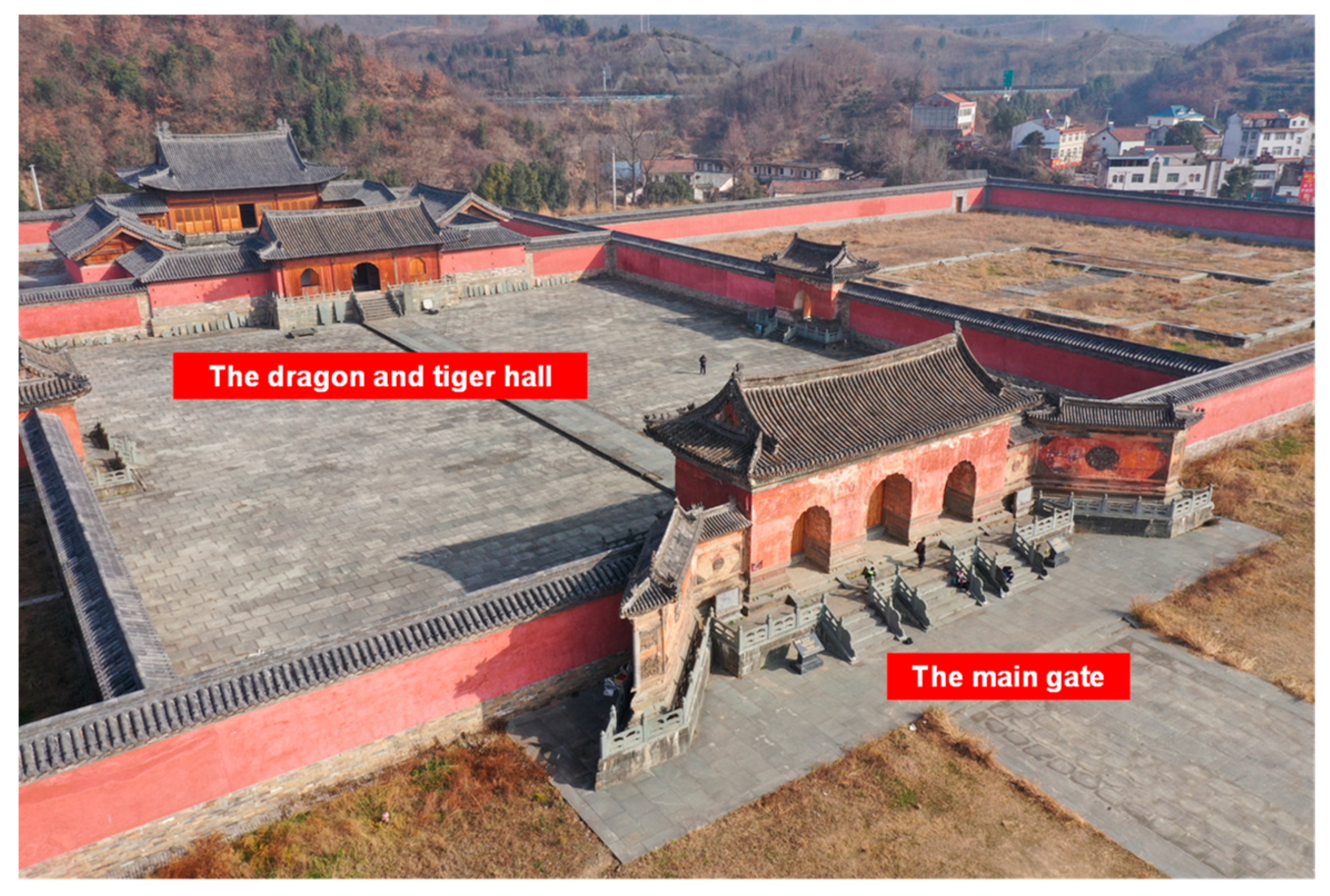
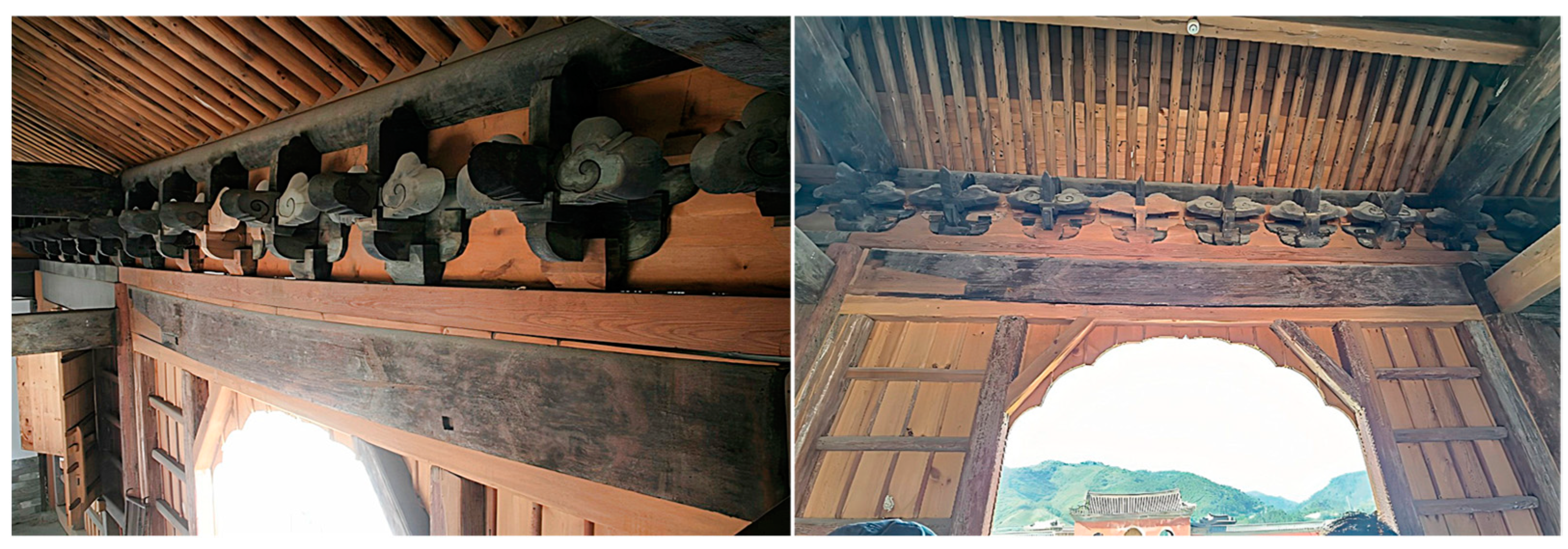


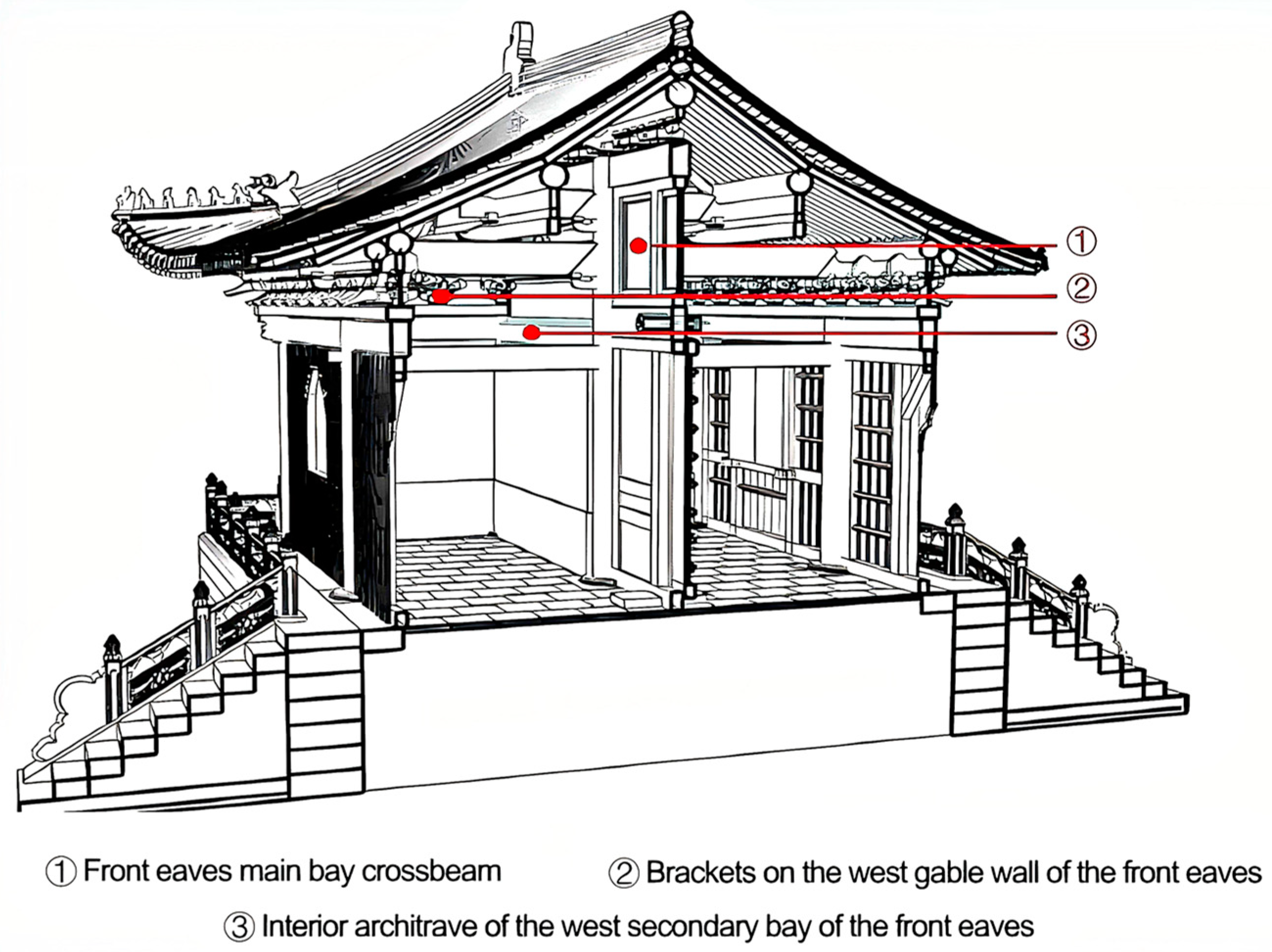



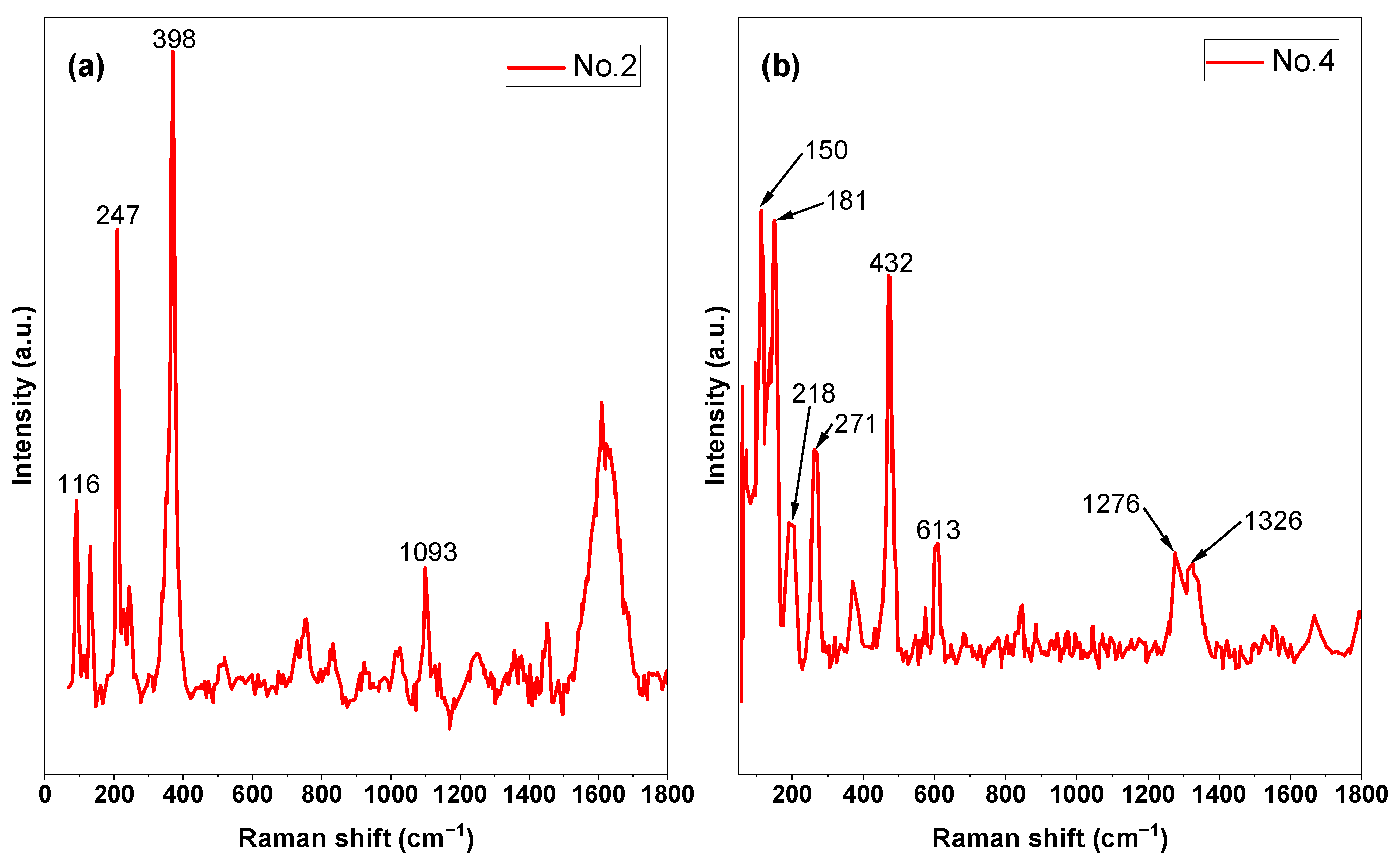
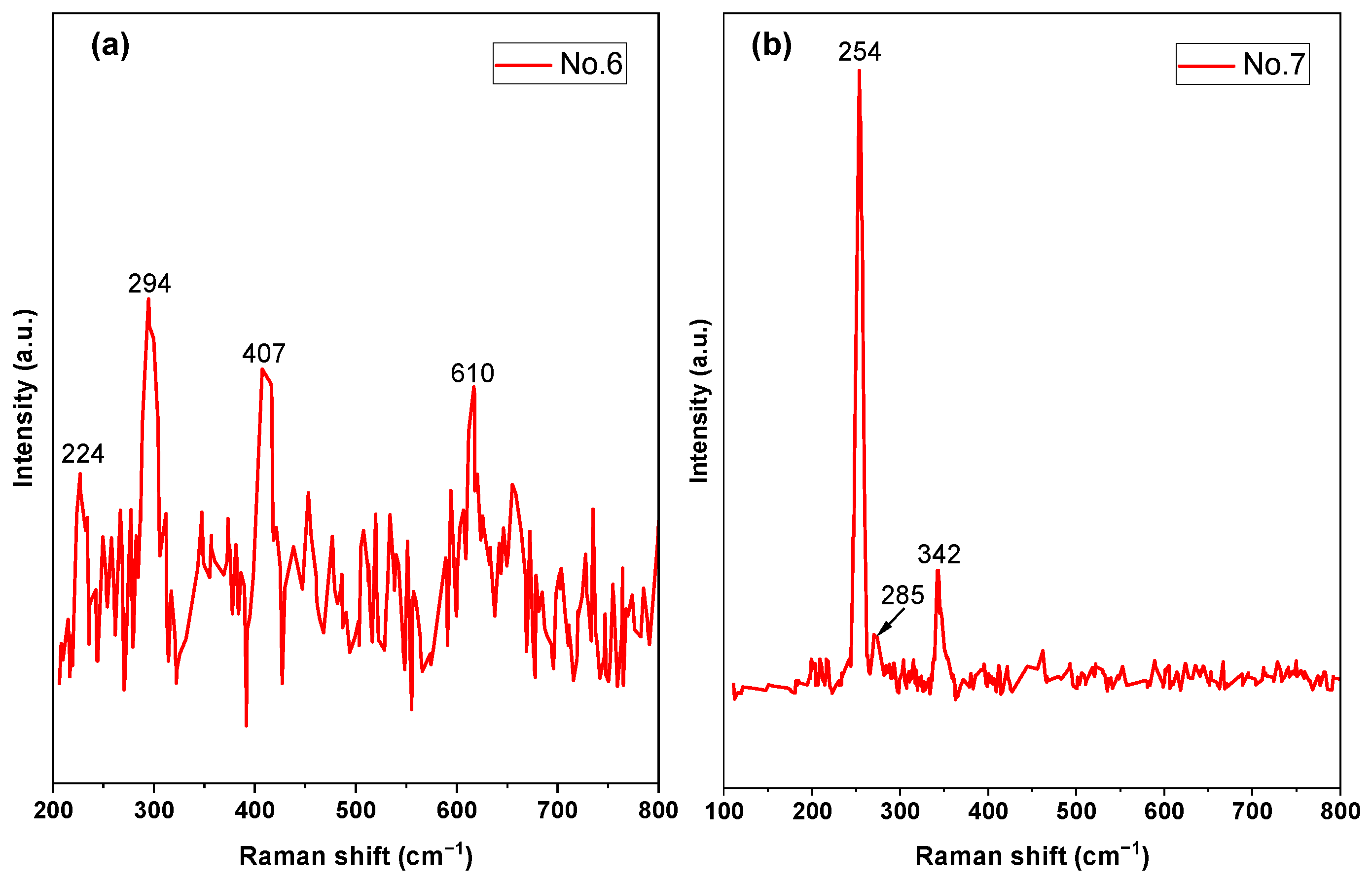


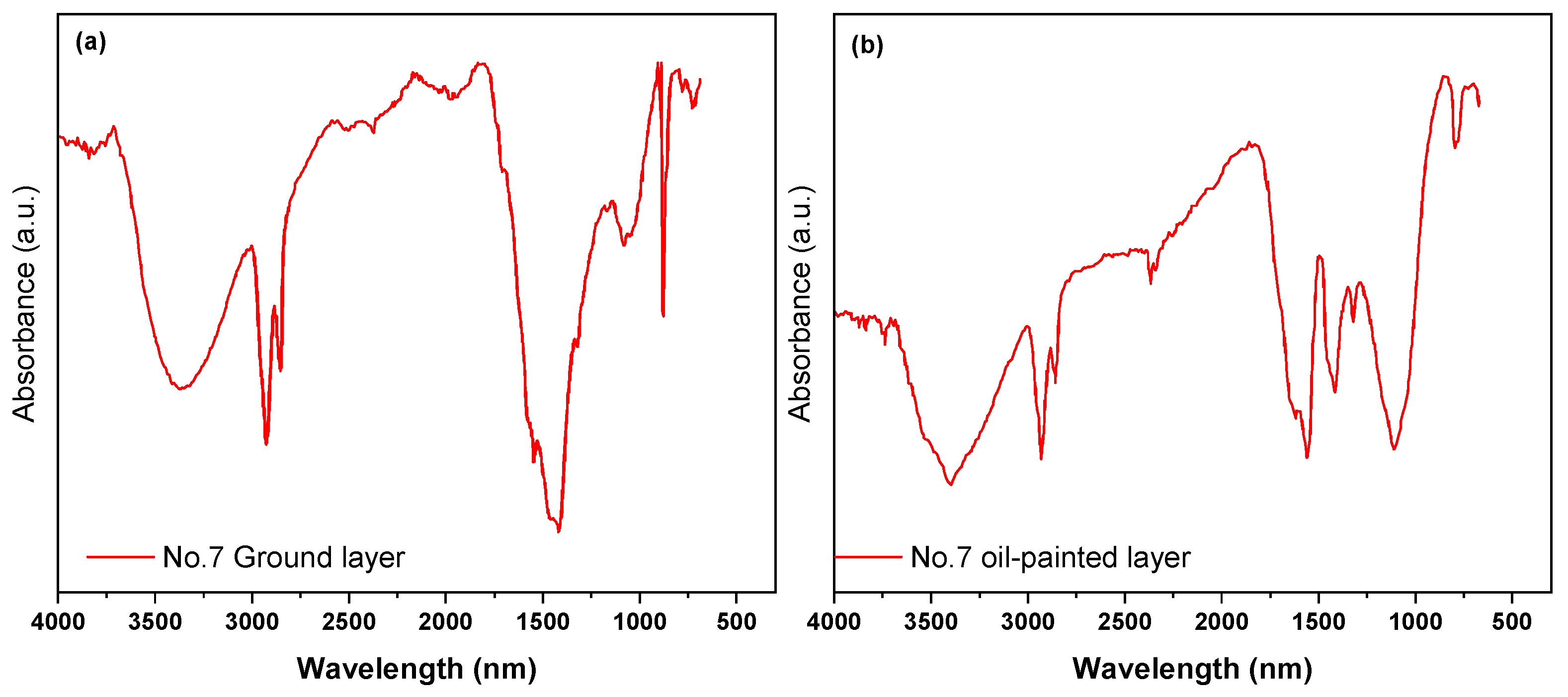
| Sample No. | Wavenumber (cm−1) | Peak Assignment | Ref. |
|---|---|---|---|
| 2 | 116 | Azurite | [30] |
| 247, 398 | |||
| 1093 | |||
| 4 | 150, 181, 218 | Malachite/Azurite | [30] |
| 271, 353, 432 | |||
| 1054, 1098 | Chrysocolla | [31] | |
| 6 | 224, 294 | Hematite | [32] |
| 407, 610 | |||
| 7 | 254, 285, 342 | Vermilion | [23] |
| 3 | 1333, 1596 | Carbon black | [33] |
| Atomic Percentage (at%) | ||||||||
|---|---|---|---|---|---|---|---|---|
| C | O | Si | S | Ca | Cu | Hg | Fe | |
| No. 2 | 26.5 ± 2.8 | 58.9 ± 2.6 | - | 3.0 ± 0.9 | - | 20.8 ± 4.1 | - | - |
| No. 4 | 26.0 ± 2.6 | 56.1 ± 4.0 | - | 1.1 ± 0.1 | - | 17.1 ± 2.0 | ||
| No. 6 | 53.9 ± 2.7 | 46.2 ± 10.9 | - | - | 3.0 ± 1.1 | - | - | 25.3 ± 9.4 |
| No. 7 | 25.3 ± 4.7 | 55.2 ± 6.9 | - | 17.8 ± 2.0 | - | - | 1.73 ± 0.8 | - |
| No. 3 | 45.8 ± 5.5 | 51.8 ± 4.8 | 1.3 ± 0.7 | 1.2 ± 0.4 | 3.8 ± 0.7 | 1.3 ± 0.4 | - | - |
| Wavenumber (cm−1) | Assignment | Ref. |
|---|---|---|
| 2920, 2850 | C-H stretching vibrations (organic materials) | [34] |
| 1400 | Carbonate ion (calcium carbonate, CaCO3) | [35] |
| 1000–1100 | Silicate substances (from basement layer) | [36] |
| Location | Building | Period | Pigment | Ref. |
|---|---|---|---|---|
| Wudangshan, China | Yuzhen Palace | Ming | Blue—azurite, Green—malachite, Red—vermilion and hematite | - |
| Beijing, China | Palace Museum | Qing | Green—auramine O and malachite green. Blue and cyan—methylene blue, methyl violet, rhoduline blue, and crystal violet. Red—eosin Y | [37] |
| Beijing, China | Jiangxue Palace | Ming | Emerald green, lead white, and lead red (minium). | [38] |
| Beijing, China | Wuying Hall | Ming | Lampblack, ultramarine blue/lapis lazuli, dolomite, emerald green, and gypsum. | [39] |
| Guangyuan, China | Thousand-Buddha Grotto | Tang | Green—malachite and atacamite, Red—minium, hematite, and cinnabar, Blue—lazurite and organic blue materials, White—anglesite and gypsum. | [17] |
| Tibet, China | Jokhang Temple | Tang | Cinnabar, malachite, azurite, orpiment, red lead, synthetic ultramarine blue, and emerald green. | [29] |
| Yixing, China | Taiping Heavenly Kingdom Royal Residence | Qing | Vermilion, graphite, white lead (2PbCO3·Pb(OH)2), and lead red (Pb3O4). | [16] |
| Shaanxi, China | Cangjie Temple | - | Cinnabar, lapis lazuli, lead white, Paris green, and carbon black. | [40] |
Disclaimer/Publisher’s Note: The statements, opinions and data contained in all publications are solely those of the individual author(s) and contributor(s) and not of MDPI and/or the editor(s). MDPI and/or the editor(s) disclaim responsibility for any injury to people or property resulting from any ideas, methods, instructions or products referred to in the content. |
© 2024 by the authors. Licensee MDPI, Basel, Switzerland. This article is an open access article distributed under the terms and conditions of the Creative Commons Attribution (CC BY) license (https://creativecommons.org/licenses/by/4.0/).
Share and Cite
Zhu, Y.; Qi, G.; Guo, Y.; Wang, D. Analysis of Decorative Paintings in the Dragon and Tiger Hall of Yuzhen Palace: Culture, Materials, and Technology. Coatings 2024, 14, 1022. https://doi.org/10.3390/coatings14081022
Zhu Y, Qi G, Guo Y, Wang D. Analysis of Decorative Paintings in the Dragon and Tiger Hall of Yuzhen Palace: Culture, Materials, and Technology. Coatings. 2024; 14(8):1022. https://doi.org/10.3390/coatings14081022
Chicago/Turabian StyleZhu, Yuhua, Guodong Qi, Yingmei Guo, and Dongmin Wang. 2024. "Analysis of Decorative Paintings in the Dragon and Tiger Hall of Yuzhen Palace: Culture, Materials, and Technology" Coatings 14, no. 8: 1022. https://doi.org/10.3390/coatings14081022





